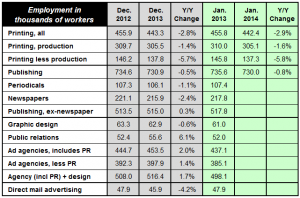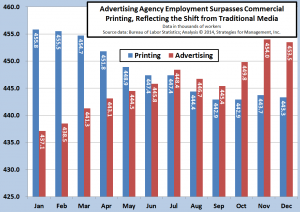Commentary & Analysis
Ad Agency Employment Surpasses Commercial Printing Employment
Today'
Today's unemployment report was relatively benign, with, in the Bureau of Labor Statistics own words, "the unemployment rate was little changed at 6.6 percent." There were, however, major historical revisions to employment data for each industry.
The major news in the data update is that employment in advertising agencies surpassed that of the printing industry in July 2013. For 2013, printing employment was down by -12,600 (-2.8%). The biggest change was in employees outside of production who were -8,400 of that decline (-5.7%). Graphic design employment was down slightly for the year, but these data do not include freelancers, which are an essential part of that business. Inside the advertising agency employment data are public relations employees, the main area of employment growth in this sector. (Click chart to enlarge).
The widest divergence between printing and advertising agency employment was in February 1995, when printing employment was 816,800 and advertising employment was 385,300. Printing employment would peak in May 1998 at 830,200. Advertising agency employment still had room to grow, and peaked in October and November 2000, at 504,000.
By mid-1998, web sites started to have an effect on print, but the industry still had strong sales and profits were excellent through 2000.
Agencies had a great late 1990s with buckets of money hurled their way by "dot-coms" attempting to gain recognition of their brand names and their web addresses. The companies spent heavily on television and print: the Internet was still being established, so traditional media was the only way to go. The advertising worked: everyone knew pets.com and their sock puppet, but unfortunately no one shopped there. Advertising can create awareness, but experience creates customers.
By 2000, broadband emerged and started its slow growth to where it dominates today. Advertising entered almost a decade of employment decline, bottoming at 402,100 in January 2010. Since then, it has grown to more than 450,000. Agencies have changed their product mix to include search engine optimization, social media, and other new formats. The new employment data underscore the media shift. Even though ad agency employment has increased, the industry still has to constantly redefine its role in the communications marketplace. It will take a while for advertising agency employment to get back up to its Internet bubble levels. The industry's increase from January 2010 bottom is an impressive rebound in a period of media restructuring, but even agencies have to compete with new media giants such as Google, Facebook, LinkedIn, and others yet to come.
# # #
About Dr. Joe Webb
Dr. Joe Webb is one of the graphic arts industry's best-known consultants, forecasters, and commentators. He is the director of WhatTheyThink's Economics and Research Center.
Video Center
- Questions to ask about inkjet for corrugated packaging
- Can Chinese OEMs challenge Western manufacturers?
- The #1 Question When Selling Inkjet
- Integrator perspective on Konica Minolta printheads
- Surfing the Waves of Inkjet
- Kyocera Nixka talks inkjet integration trends
- B2B Customer Tours
- Keeping Inkjet Tickled Pink
© 2024 WhatTheyThink. All Rights Reserved.
















